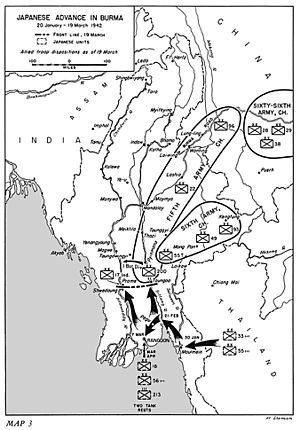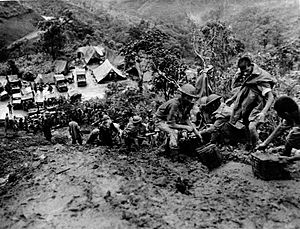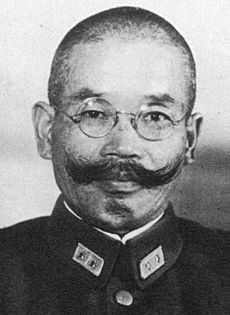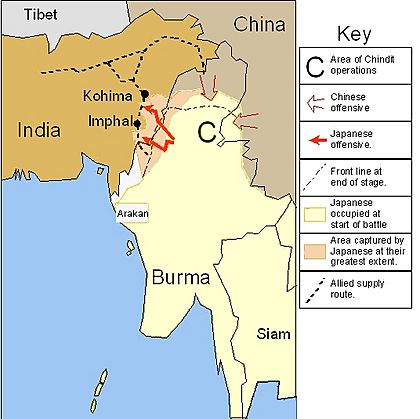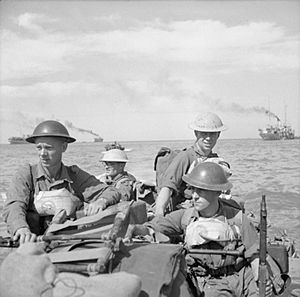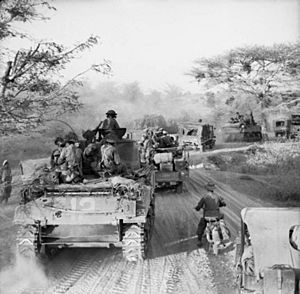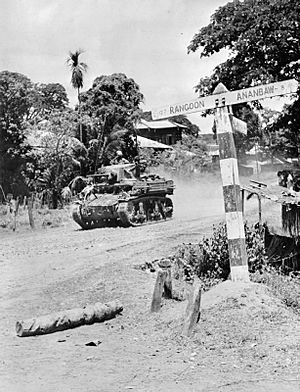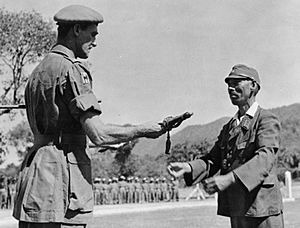Burma campaign facts for kids
Quick facts for kids Burma campaign |
|||||||||
|---|---|---|---|---|---|---|---|---|---|
| Part of the Pacific War during World War II | |||||||||
 Sikh soldiers of the 7th Indian Infantry Division at an observation post in the Ngakyedauk Pass, February 1944 |
|||||||||
|
|||||||||
| Belligerents | |||||||||
|
|
||||||||
| Commanders and leaders | |||||||||
|
|
||||||||
| Strength | |||||||||
| 1942–1943 1944–1945 |
1942–1943 1944–1945 |
||||||||
| Casualties and losses | |||||||||
|
|
|
||||||||
| 250,000 to 1,000,000 Burmese civilians killed | |||||||||
The Burma campaign was a series of important battles fought in Burma during World War II. Burma was a British colony at the time. This campaign was part of the larger Pacific War in Southeast Asia.
The main groups fighting were the Allies against the Empire of Japan. The Allies included forces from the British Empire (like soldiers from India and other colonies), the Republic of China, and the United States. Japan had help from Thailand and local groups in Burma and India who wanted independence from British rule.
Japan quickly took over Burma in 1942. They set up new governments there that were controlled by Japan. For a while, the Allies tried to fight back but didn't succeed. However, by 1944, the Allied forces grew much stronger. They had about a million soldiers and airmen, mostly from British India. These forces helped the Allies take Burma back in 1945.
The fighting in Burma was very tough because of the jungle, mountains, and heavy monsoon rains. Disease was also a big problem. Moving supplies and troops was hard, so air transport became very important. The campaign also had many political challenges, as the British, Americans, and Chinese had different goals. It was the only land campaign in the Pacific that lasted from the start of the war until the end.
The campaign happened in four main parts:
- Japan's invasion and taking over Burma in 1942.
- Allied attempts to attack Burma from late 1942 to early 1944, which mostly failed.
- Japan's invasion of India in 1944, which was stopped at the battles of Imphal and Kohima.
- The successful Allied push to free Burma from late 1944 to mid-1945.
The war in Burma also affected the local people. Japan promised "Greater East Asia Co-Prosperity Sphere", which meant Asian countries would be free from Western rule. But Japanese military leaders often acted like rulers, which made local people unhappy. This led to a revolt by the Burmese army against Japan in 1945. After the war, the campaign played a big part in Burma and India gaining their independence.
Contents
Japan Takes Over Burma
Japan's first goal in Burma was to capture Rangoon, the capital city and a major port. This would cut off a key supply route to China and protect Japan's other gains in Asia. In January 1942, the Japanese army, led by Lieutenant General Shōjirō Iida, moved into southern Burma from Thailand.
As the Japanese advanced, many people, especially Indians, Anglo-Indians, and Anglo-Burmese, fled Burma. About 600,000 people left by late 1942. Sadly, around 80,000 of them died from hunger, tiredness, and sickness during their journey.
The Japanese quickly captured the port of Moulmein. They then moved north, getting around British defenses. British Indian troops tried to retreat over the Sittaung River, but the Japanese got to the important bridge first. On February 22, the bridge was blown up to stop the Japanese from using it. This decision was very controversial.
Losing so many troops meant Rangoon couldn't be defended. General Archibald Wavell, the Allied commander, still ordered the city to be held, hoping for more soldiers from the Middle East. But counterattacks failed. The new commander, General Harold Alexander, ordered the city to be left on March 7. The port and oil refinery were destroyed before the Allies left.
In the eastern part of the front, Chinese forces fought hard but eventually had to retreat. Japanese troops captured Lashio, which cut off the Chinese armies from their home province of Yunnan. With their defenses broken, the Allied forces had to retreat overland to either India or Yunnan.
Japan Reaches the Indian Border
After Rangoon fell in March 1942, the Allies tried to hold their ground in northern Burma. They were joined by a Chinese army. But the Japanese, who had also received more troops, defeated both the British and Chinese forces. The Allies also faced more Burmese rebels, and the government in the areas they still held started to break down.
With their supplies cut off, the Allied commanders decided to leave Burma. On April 16, about 7,000 British soldiers were surrounded by the Japanese during the Battle of Yenangyaung. They were saved by the Chinese 38th Division.
The retreat was very difficult. Hungry refugees, lost soldiers, and the sick and wounded filled the rough roads leading to India. The British forces reached Imphal, India, just before the monsoon rains started in May 1942. They had lost most of their equipment. They found themselves living outside in heavy rain, which was very unhealthy.
Many Chinese soldiers didn't know about the British retreat. Realizing they couldn't win alone, some Chinese troops made a quick, messy retreat to India. There, they were trained and given new equipment by American instructors. Other Chinese troops tried to go back to Yunnan through tough mountain forests, and at least half of them died.
Thai Army Enters Burma
Thailand had signed an agreement with Japan in December 1941. On March 21, 1942, they agreed that the Karenni State and Shan States would be controlled by Thailand. The rest of Burma would be under Japanese control.
On May 10, 1942, the Thai army, led by General Jarun Rattanakun Seriroengrit, entered the Shan States. Three Thai infantry divisions and one cavalry division, supported by the Royal Thai Air Force, fought the retreating Chinese 93rd Division. They captured Kengtung on May 27. The Thais controlled the Shan States for the rest of the war. Their troops faced supply problems and disease but were not attacked by the Allies.
Allied Struggles, 1942–1943
After the monsoon ended, the Japanese didn't attack again. They set up a Burmese government led by Ba Maw, which was controlled by Japan. The Burma Independence Army was also reformed under General Aung San.
For the Allies, operations in Burma in 1942 and 1943 were frustrating. Britain could only fight in three major areas, and the Middle East was given priority. This was because it was closer to home and the Allies had a "Germany First" policy.
Building up Allied forces was also hard because eastern India was in chaos. There were protests and a terrible famine in Bengal that may have caused 3 million deaths. These problems made it difficult to get supplies to the front lines. Also, the Allied troops had low morale and many got sick, which weakened their fighting ability.
Despite this, the Allies tried two operations in 1942–1943. The first was a small attack into the coastal area of Arakan Province. Indian forces tried to take back the Mayu peninsula and Akyab Island, which had an important airfield. But a small, well-dug-in Japanese force stopped them. The Allies didn't have the right tools or tactics to break through strong Japanese bunkers. Repeated attacks failed, and the Allies suffered heavy losses. Japanese reinforcements arrived and attacked the Allies from the side, forcing them to retreat almost to the Indian border.
The second operation was led by Brigadier Orde Wingate. His special unit, the Chindits, went deep into Burma behind Japanese lines. Their goal was to cut the main railway in northern Burma. About 3,000 men went into Burma. They did damage Japanese communications, cutting the railway for about two weeks, but they also suffered many losses. Even though the results were debated, the operation was used to show that British and Indian soldiers could fight well in the jungle, just like the Japanese. This helped boost morale among Allied troops.
The War Changes in 1943–1944
From late 1943 to late 1944, the war in Burma changed a lot. Allied leaders, training, and supplies improved. They also had more firepower and better air control. This gave the Allied forces confidence they didn't have before. In Arakan, the Indian XV Indian Corps stopped a Japanese counterattack. The Japanese invasion of India also failed, causing them huge losses.
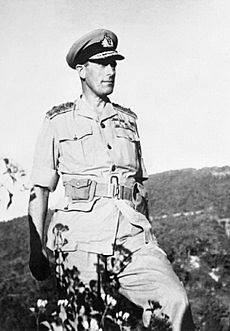
Allied Plans
In August 1943, the Allies created a new command called South East Asia Command (SEAC), led by Admiral Louis Mountbatten. The training, equipment, health, and morale of Allied troops under Lieutenant General William Slim were getting better. The supply lines in North-eastern India also improved. A new idea was to use aircraft a lot to move and supply troops.
SEAC had many plans, but some had to be canceled because there weren't enough resources. For example, plans for landings on the Andaman Islands were stopped because the landing craft were needed in Europe for the Normandy Landings.
The main effort was to be made by American-trained Chinese troops, led by General Joseph Stilwell. Their job was to help build the Ledo Road. Orde Wingate's Chindit force was also greatly expanded to help Stilwell by disrupting Japanese supply lines. China also agreed to launch an attack from Yunnan.
Under the British Fourteenth Army, the Indian XV Corps prepared to attack again in Arakan province. The IV Corps started a small advance from Imphal to distract the Japanese.
Japanese Plans
Around the same time, the Japanese created the Burma Area Army, led by Lieutenant General Masakazu Kawabe. The new commander of the Fifteenth Army, Lieutenant General Renya Mutaguchi, really wanted to attack India. At first, his superiors disagreed, but eventually, even the top command in Tokyo approved his plan.
The Japanese were also influenced by Subhas Chandra Bose, who led the Indian National Army. This army was made up of Indian soldiers captured in Malaya or Singapore, and Indians living in Malaya. Bose wanted to march on Delhi, India's capital. Both Bose and Mutaguchi believed that attacking India would bring great advantages. Despite doubts from some Japanese officers, Operation U-Go was launched.
Northern and Yunnan Front 1943/44
Stilwell's forces, called X Force, included two Chinese divisions with American equipment and an American long-range unit called "Merrill's Marauders".
In 1943, the Thai army tried to invade Xishuangbanna in China but was pushed back by Chinese forces.
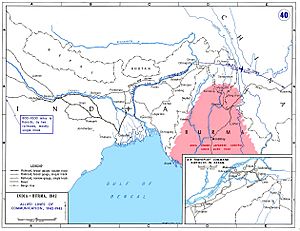
In October 1943, the Chinese 38th Division began to advance from Ledo, Assam towards Myitkyina and Mogaung. American engineers built the Ledo Road behind them. The Japanese 18th Division was often outflanked by Merrill's Marauders.
In Operation Thursday, the Chindits were supposed to help Stilwell by cutting Japanese communications. One brigade started marching in February 1944. In March, three more brigades were flown behind Japanese lines by the Royal Air Force and the USAAF. They set up strongholds around Indaw.
Meanwhile, Chinese forces on the Yunnan front, called Y Force, attacked in April. Nearly 75,000 troops crossed the Salween river. Soon, about 175,000 Chinese soldiers were attacking the Japanese 56th Division. The Japanese in the North were now fighting on two fronts.
On May 17, control of the Chindits passed to Stilwell. The Chindits moved closer to Stilwell's front and were given new tasks. They achieved some goals but suffered many losses. By the end of June, they joined Stilwell's forces but were exhausted and sent back to India.
Also on May 17, a force of Chinese regiments, Merrill's Marauders, and Kachin guerrillas captured the airfield at Myitkyina. The Allies didn't follow up immediately, so the Japanese reinforced the town. It fell only after a long siege on August 3. But capturing the Myitkyina airfield helped secure the air route from India to Chongqing over the Hump.
By the end of May, the Yunnan attack, despite monsoon rains and lack of air support, destroyed the Japanese garrison at Tengchong and reached Longling. But strong Japanese reinforcements counterattacked and stopped the Chinese advance.
Southern Front 1943/44
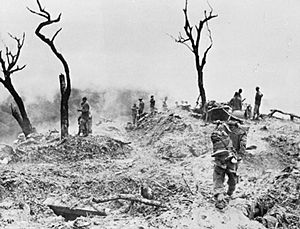
In Arakan, Indian XV Corps, led by Lieutenant General Philip Christison, continued its advance. The 5th Indian Infantry Division captured the small port of Maungdaw on January 9, 1944. The Japanese then attacked the 7th Indian Infantry Division from behind, overrunning their headquarters.
Unlike before, the Allied forces held their ground. Supplies were dropped to them by parachute. In the Battle of the Admin Box from February 5 to 23, the Japanese focused on the XV Corps' supply area. But they couldn't handle the tanks supporting the defenders. Troops from the 5th Indian Division broke through to help. Even though both sides had similar battle losses, it was a big defeat for the Japanese. Their tactics of sneaking behind lines and surrounding enemies had failed to scare the Allied troops. Since the Japanese couldn't capture enemy supplies, they starved.
Over the next few weeks, the XV Corps' attack ended as the Allies focused on the Central Front. After capturing the railway tunnels, XV Corps stopped during the monsoon.
Japan Invades India 1944
The IV Corps, led by Lieutenant-General Geoffry Scoones, had moved two divisions to the Chindwin River. One division was kept in reserve at Imphal. There were signs that a major Japanese attack was coming. Slim and Scoones planned to pull back their troops to make the Japanese fight with very long supply lines. However, they misjudged when the Japanese would attack and how strong they would be.
The Japanese Fifteenth Army had three infantry divisions and a special unit, plus a regiment from the Indian National Army. Mutaguchi, the Army commander, planned to cut off and destroy the IV Corps divisions before capturing Imphal. The Japanese 31st Division was to isolate Imphal by capturing Kohima. Mutaguchi wanted to then capture the important city of Dimapur, which would cut off supplies to Stilwell's forces and the airbases used to supply the Chinese.
Japanese troops crossed the Chindwin River on March 8. Scoones and Slim were slow to order their forward troops to retreat. The 17th Indian Infantry Division was cut off at Tiddim. It fought its way back to Imphal with help from Scoones's reserve division, which received supplies by parachute. North of Imphal, the 50th Indian Parachute Brigade was defeated at Sangshak by a Japanese regiment heading to Kohima. This left Imphal open to attack from the north. But because the Japanese attack in Arakan had already failed, Slim was able to move the 5th Indian Division by air to the Central Front.
By early April, IV Corps had gathered in the Imphal plain. The Japanese launched several attacks, but they were pushed back. In early May, Slim and Scoones began a counter-attack against the Japanese 15th Division north of Imphal. Progress was slow due to monsoon rains and supply shortages for IV Corps.
Also in early April, the Japanese 31st Division, led by Lieutenant-General Kotoku Sato, reached Kohima. Instead of just isolating the small British force there and moving on to Dimapur, Sato decided to capture the hill station. The siege lasted from April 5 to 18, when the tired defenders were finally relieved. A new command, the Indian XXXIII Corps, took over operations on this front. The 2nd British Infantry Division began a counter-attack and by May 15, they had pushed the Japanese off Kohima Ridge.
By now, the Japanese were exhausted. Their troops were starving, and disease spread quickly during the monsoon. Lieutenant-General Sato told Mutaguchi that his division would retreat from Kohima by the end of May if they didn't get supplies. Despite orders to hold on, Sato did retreat. The leading troops of IV Corps and XXXIII Corps met on June 22, and the siege of Imphal was lifted.

Mutaguchi and Kawabe kept ordering new attacks. But by the end of June, the Japanese had suffered so many losses from battle and disease that they couldn't make any progress. The Imphal operation was finally called off in early July, and the Japanese painfully retreated to the Chindwin River.
This was the biggest defeat in Japanese history at that time. They had lost 50,000–60,000 dead, and 100,000 or more wounded or sick. Most of these losses were due to disease, hunger, and exhaustion. The Allies had 12,500 casualties, including 2,269 killed. Mutaguchi was later removed from his command.
During the monsoon from August to November, the Fourteenth Army chased the Japanese to the Chindwin River. By the end of November, Kalewa was recaptured, and the Allies had set up positions on the east bank of the Chindwin.
Allies Take Burma 1944–1945
The Allies launched a series of attacks into Burma from late 1944 to mid-1945. The Japanese also made big changes to their command. General Hyotaro Kimura replaced General Kawabe at the Burma Area Army. Kimura surprised the Allies by refusing to fight at the Chindwin River. He pulled his forces back behind the Irrawaddy River. This forced the Allies to stretch their supply lines much further.
Southern Front 1944/45
In Arakan, XV Corps continued its advance on Akyab Island. This time, the Japanese were much weaker and retreated. They left Akyab Island on December 31, 1944. XV Corps occupied it without a fight on January 3, 1945.
The Allies now had landing craft. XV Corps launched attacks on the Myebon peninsula on January 12, 1945, and at Kangaw ten days later. This was to cut off the retreating Japanese. There was heavy fighting, and the Japanese suffered many losses.
An important goal for XV Corps was to capture Ramree Island and Cheduba Island. They wanted to build airfields there to support Allied operations in Central Burma. Most of the Japanese soldiers on Ramree Island died during the Battle of Ramree Island. XV Corps' operations on the mainland were reduced to free up transport aircraft for the Fourteenth Army.
Northern Front 1944/45
NCAC continued its advance in late 1944. On December 10, 1944, the 36th British Infantry Division met units of the Fourteenth Army in Northern Burma. Five days later, Chinese troops captured the city of Bhamo.
NCAC connected with China's Yunnan armies on January 21, 1945. The Ledo Road could finally be completed, though its importance was uncertain by then. China ordered the American General Daniel Isom Sultan, who led NCAC, to stop his advance at Lashio, which was captured on March 7. This was a blow to British plans because it made it harder to reach Yangon before the monsoon. From April 1, NCAC's operations stopped, and its units returned to China and India. A US-led guerrilla force, OSS Detachment 101, took over the remaining military duties.
Central Front 1944/45
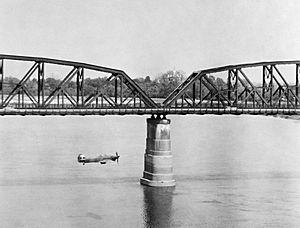
The Fourteenth Army, made up of IV Corps and XXXIII Corps, led the main attack into Burma. The Japanese retreat across the Irrawaddy forced the Allies to change their plans completely, but they had so many resources that they could do it. IV Corps secretly moved to the left side of the army. It aimed to cross the Irrawaddy near Pakokku and capture Meiktila, a key Japanese supply center. XXXIII Corps continued to advance on Mandalay.
In January and February 1945, XXXIII Corps captured crossings over the Irrawaddy River near Mandalay. There was heavy fighting, which drew in Japanese reserve troops. In late February, the 7th Indian Division, leading IV Corps, captured crossings near Pakokku. The 17th Indian Division and 255th Indian Tank Brigade followed and headed for Meiktila. In the open areas of Central Burma, this force outsmarted the Japanese and attacked Meiktila on March 1. The town was captured in four days, despite fierce resistance.
The Japanese tried to relieve the Meiktila garrison and then recapture the town. But their attacks were not well planned and were pushed back. By the end of March, the Japanese had suffered heavy losses and lost most of their artillery. They stopped the attack and retreated.
XXXIII Corps had renewed its attack on Mandalay. It fell to the 19th Indian Division on March 20. Much of Mandalay's historic and cultural sites were burned down.
Race for Rangoon
Even though the Allies had advanced successfully into central Burma, it was very important to capture the port of Rangoon before the monsoon season began. This would prevent a major supply crisis. In spring 1945, another factor in the race for Rangoon was the work of Force 136, a secret Allied organization. Their efforts led to a national uprising in Burma and the entire Burma National Army switching sides to join the Allies. So, besides the Allied advance, the Japanese now faced open rebellion behind their lines.
XXXIII Corps led the Fourteenth Army's secondary push down the Irrawaddy River valley. IV Corps made the main attack down the "Railway Valley." They first attacked a Japanese position at Pyawbwe. The attackers were stopped at first, but a flanking move by tanks and mechanized infantry attacked the Japanese from behind and broke their defenses.
From this point, the advance down the main road to Rangoon faced little organized resistance. An uprising by Karen guerrillas stopped Japanese troops from reaching the major road center of Taungoo before IV Corps captured it. The leading Allied troops met Japanese rearguards north of Bago, about 40 miles north of Rangoon, on April 25. Heitarō Kimura had formed various service troops and civilians in Yangon into a new brigade. This group held up the British advance until April 30 and covered the evacuation of the Rangoon area.
Operation Dracula
The original plan to retake Burma included XV Corps making a landing attack on Rangoon before the Fourteenth Army reached the capital. This operation, called Operation Dracula, was delayed many times.
Slim feared that the Japanese would defend Rangoon through the monsoon, which would cause huge supply problems for the Fourteenth Army. So, he asked for Operation Dracula to be launched quickly. Naval forces planned for another attack were sent to Operation Dracula. Units of XV Corps were loaded onto ships from Akyab and Ramree.
On May 1, a Gurkha parachute battalion landed at Elephant Point and cleared Japanese rearguards from the mouth of the Yangon River. The 26th Indian Infantry Division landed by ship the next day. When they arrived, they found that Kimura had ordered Rangoon to be evacuated, starting on April 22. On the afternoon of May 2, 1945, the monsoon rains began in full force. The Allied effort to free Rangoon before the rains succeeded with only a few hours to spare.
The leading troops of the 17th and 26th Indian divisions met at Hlegu, about 28 miles north of Rangoon, on May 6.
Final Operations
After the Allies captured Rangoon, a new Twelfth Army headquarters was created to control the forces remaining in Burma.
The Japanese Twenty-Eighth Army, after retreating from Arakan and fighting XXXIII Corps, pulled back into the Pegu Yomas, a range of jungle-covered hills. They planned to break out and rejoin the Burma Area Army. To help this breakout, Kimura ordered the Thirty-Third Army to launch a fake attack across the Sittang River. On July 3, they attacked British positions. On July 10, after a battle in flooded areas, both the Japanese and Allies pulled back.
The Japanese had attacked too early. The Twenty-Eighth Army was not ready to start its breakout until July 17. The breakout was a disaster. The British had set up ambushes and artillery in the Japanese escape routes. Hundreds of men drowned trying to cross the swollen Sittang River. Burmese guerrillas and bandits killed stragglers east of the river. The breakout cost the Japanese nearly 10,000 men, half the strength of the Twenty-Eighth Army. British and Indian losses were very small.
The Fourteenth Army and XV Corps returned to India to plan the next stage of the campaign to retake Southeast Asia. A new corps, the Indian XXXIV Corps, was formed for future operations.
This was to be a landing attack on the western side of Malaya, called Operation Zipper. The dropping of the atomic bombs stopped this operation from being a combat mission, but it was still carried out after the war to get occupation troops into Malaya quickly.
Results of the Burma Campaign
Overall, taking back Burma is seen as a great victory for the British Indian Army. It was the biggest defeat the Japanese armies had suffered up to that point.
The Japanese invasion of India in 1944 was based on unrealistic ideas. After the losses in Singapore and Burma in 1942, the British had to defend India at all costs. A successful Japanese invasion would have been disastrous. The defense operations at Kohima and Imphal in 1944 are now seen as a huge turning point for British fortunes in the war in the East.
An American historian, Raymond Callahan, said that "Slim's great victory... helped the British... to leave Asia with some dignity."
After the war, the desire for independence among the Burmese people and the economic damage to Burma during the four-year campaign made it impossible for the old British rule to return. Within three years, both Burma and India became independent countries.
American goals in Burma were to help the Chinese Nationalist government. Besides the "Hump" airlift, these efforts didn't really help until very late in the war, so they didn't contribute much to Japan's defeat.
See also
- India in World War II
- Japanese occupation of Burma
- Second Sino-Japanese War
- Soviet invasion of Manchuria
Sources
- Allen, Louis, Burma: The Longest War
- Carew, Tim. The Longest Retreat
- Calvert, Mike. Fighting Mad has content related to the 1944 Chindit campaign
- Dillon, Terence. Yangon to Kohima
- Fujino, Hideo. Singapore and Burma
- Grant, Ian Lyall, & Tamayama, Kazuo, Burma 1942: The Japanese Invasion
- Iida, Shojiro From the Battlefields
- Ikuhiko Hata, Road to the Pacific War
- Hickey, Michael. The Unforgettable Army
- Hodsun, J. L. War in the Sun
- Latimer, Jon. Burma: The Forgotten War
- Lunt, James. 'A Hell of a Licking' – The Retreat from Burma 1941–2 London 1986 ISBN: 0-00-272707-2. Personal account by a British Burma Rifles officer, who later became an Oxford academic.
- McLynn, Frank. The Burma Campaign: Disaster Into Triumph, 1942–45 (Yale University Press; 2011), 532 pages; focus on William Slim, Orde Wingate, Louis Mountbatten, and Joseph Stilwell.
- Ochi, Harumi. Struggle in Burma
- Reynolds, E. Bruce. Thailand and Japan's Southern Advance
- Rolo, Charles J. Wingate's Raiders
- Sadayoshi Shigematsu, Fighting Around Burma
- Smyth John Before the Dawn
- Sugita, Saiichi. Burma Operations
- Thompson, Robert. Make for the Hills has content related to the 1944 Chindit campaign
- Thompson, Julian. Forgotten Voices of Burma: The Second World War's Forgotten Conflict
- Webster, Donovan. The Burma Road : The Epic Story of the China-Burma-India Theater in World War II
- Williams, James Howard was Elephant Advisor to the Fourteenth Army, see his Elephant Bill (1950) and Bandoola (1953)
- Young, Edward M. Aerial Nationalism: A History of Aviation in Thailand


